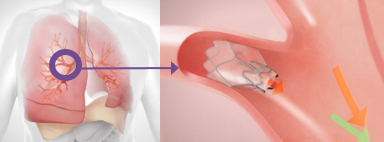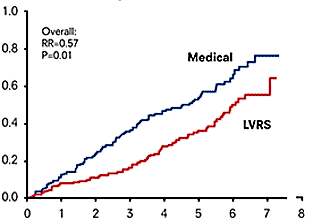Lung Volume Reduction for Emphysema
NewYork-Presbyterian has earned an international reputation for the depth of our clinical expertise in the diagnosis and treatment of pulmonary disease. Our lung care professionals are highly experienced in the use of novel "lung volume reduction" techniques to treat debilitating shortness of breath in people with severe emphysema.

Lung Volume Reduction using Endobronchial Valves 2014 Pulmonx
Our multidisciplinary teams use innovative surgical and nonsurgical approaches to reduce the size of highly damaged areas of the lungs that contribute to breathing difficulties. Our experts tailor an individualized plan of care to optimize each patient's outcomes. We offer the most comprehensive treatments, including medication recommendations, pulmonary rehabilitation, lung volume reduction surgery, endobronchial valve placement, and referral for lung transplantation. Our goal is to help you breathe easier, improve your lung function, and enhance your quality of life.
What causes shortness of breath in emphysema?
In people with severe emphysema, air becomes trapped in damaged areas of the lungs and cannot be exhaled — a problem called "hyperinflation." As air collects in the diseased parts of the lungs, the size of the lungs (lung volume) increases and can put pressure on the diaphragm and healthy lung tissue. This makes it challenging to take deep, full breaths. NewYork-Presbyterian's lung care professionals offer lung volume reduction procedures designed to stop the cycle of breathlessness caused by hyperinflation.
Endoscopic Lung Volume Reduction
NewYork-Presbyterian/Columbia have programs that are among the busiest in New York City for the placement of special valves into damaged parts of the lungs to improve breathing in patients with severe emphysema who are not candidates for LVRS. These valves allow air to escape, but not get in. An interventional pulmonologist inserts these valves during an outpatient procedure using a bronchoscope — a flexible thin tube with a tiny camera that passes through your mouth, down your throat, and into your lungs. By allowing air to exit these diseased areas of the lung but blocking air from entering, lung volume decreases and healthier areas can function more efficiently.
After endobronchial lung volume reduction, patients are able to walk further and perform more activities of daily living, and some are even able to get off oxygen. They have reported:
- Less shortness of breath
- Better exercise tolerance
- Improvement in walking/climbing stairs
- Less need for prednisone
- Less oxygen requirement
- Improvement in lung function on pulmonary function testing
Minimally Invasive Lung Volume Reduction Surgery
Lung volume reduction surgery (LVRS) — an operation to remove the most damaged parts of both lungs — is a specialty of thoracic surgeons at the Center for Chest Disease and Respiratory Failure at NewYork-Presbyterian/Columbia University Irving Medical Center. They remove damaged lung tissue through a minimally invasive operation called video-assisted thoracoscopic surgery (VATS), which enables them to take out up to 25-30 percent of the most damaged areas of the lung through three to five small incisions in the chest. By removing these non-functioning damaged areas, air can move in and out of the remaining healthy lung tissue more easily.

Lung Volume Reduction Surgery improves survival rates. © 2019 Nature In Human Health
This program is one of the nation’s most experienced LVRS programs. The team participated in the landmark National Emphysema Treatment Trial (NETT), which showed that in carefully selected patients, this surgery can improve quality of life, exercise capacity, lung function, and even survival. New York-Presbyterian/Columbia is the only New York City hospital — and one of only a small number of centers nationwide — to be selected by the Centers for Medicare & Medicaid Services (CMS) as a Center of Excellence for LVRS. Since the completion of NETT, our center has performed more than 120 LVRS procedures. Thanks to careful patient selection and an experienced team, we have achieved excellent patient outcomes, including a one-year survival rate of 99 percent after surgery — far better than the national average.
Which lung volume reduction procedure is best for me?
When you come to NewYork-Presbyterian for lung care, you'll have access to respiratory care teams that include pulmonologists, thoracic surgeons, interventional pulmonologists, radiologists, nurses, lung transplant specialists, and respiratory therapists. Your team will use imaging exams and other tests to conduct a thorough assessment of your heart function, lung function, and exercise capacity. Based on the results of your physical exam, tests, and imaging scans, we'll let you know if you a lung volume reduction procedure is a treatment option for you, and we'll customize your care to meet your needs. We are also committed to communicating closely with referring physicians to keep them apprised of their patient's progress. To start the evaluation process, please contact one of our programs below.



